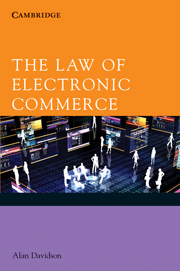Book contents
- Frontmatter
- Contents
- Acknowledgements
- Table of Cases
- Table of statutes
- 1 The law of electronic commerce
- 2 The rule of cyberspace
- 3 Electronic commerce and the law of contract
- 4 Shrinkwrap, clickwrap and browsewrap contracts
- 5 Electronic signatures
- 6 Copyright issues in electronic commerce
- 7 Electronic commerce – trade marks, patents and circuit layouts
- 8 Domain names
- 9 Domain name disputes
- 10 Uniform domain name dispute resolution policies
- 11 Jurisdiction in cyberspace
- 12 Defamation in cyberspace
- 13 Privacy and data protection in cyberspace
- 14 Electronic mail and online presence
- 15 National electronic surveillance
- 16 Cybercrime
- 17 Evidence of electronic records
- 18 Censorship – Broadcast and online content regulation
- 19 An international perspective
- Appendix A Electronic Transactions (Victoria) Act 2000
- Appendix B UNCITRAL Model Law on Electronic Commerce
- Appendix C Selected provisions Copyright Act 1968 (Cth)
- Appendix D ICANN Uniform Dispute Resolution Policy (UDRP)
- Appendix E .au Dispute Resolution Policy (auDRP)
- Appendix F National Privacy Principles
- Index
- References
2 - The rule of cyberspace
Published online by Cambridge University Press: 05 June 2012
- Frontmatter
- Contents
- Acknowledgements
- Table of Cases
- Table of statutes
- 1 The law of electronic commerce
- 2 The rule of cyberspace
- 3 Electronic commerce and the law of contract
- 4 Shrinkwrap, clickwrap and browsewrap contracts
- 5 Electronic signatures
- 6 Copyright issues in electronic commerce
- 7 Electronic commerce – trade marks, patents and circuit layouts
- 8 Domain names
- 9 Domain name disputes
- 10 Uniform domain name dispute resolution policies
- 11 Jurisdiction in cyberspace
- 12 Defamation in cyberspace
- 13 Privacy and data protection in cyberspace
- 14 Electronic mail and online presence
- 15 National electronic surveillance
- 16 Cybercrime
- 17 Evidence of electronic records
- 18 Censorship – Broadcast and online content regulation
- 19 An international perspective
- Appendix A Electronic Transactions (Victoria) Act 2000
- Appendix B UNCITRAL Model Law on Electronic Commerce
- Appendix C Selected provisions Copyright Act 1968 (Cth)
- Appendix D ICANN Uniform Dispute Resolution Policy (UDRP)
- Appendix E .au Dispute Resolution Policy (auDRP)
- Appendix F National Privacy Principles
- Index
- References
Summary
This chapter examines and contemplates law and culture in cyberspace. The role of law and indeed the rule of law have different dynamics in cyberspace as a consequence of the architecture of cyberspace and its anonymous, pseudonymous and borderless features. The resultant structural balance among technology, law and culture may be expressed as the ‘rule of cyberspace’. This spatial dimension, economic influence on human culture and the role of law and regulation together form a subculture which both impacts on and moulds electronic commerce.
First, the nature of cyberspace is examined. This is followed by consideration of theoretical bases for law and order in cyberspace. The rule of cyberspace emerges, by processes known as ‘spontaneous order’, from the environmental factors fashioning cyberspace. It is spontaneous order which best describes and to a limited extent predicts regulation for electronic commerce.
This chapter examines the juxtaposition of culture and cyberspace, a modern application of spontaneous order, and then uses a discussion of libertarian and classical approaches to predict the future of cyberspace.
Cultural and environmental juxtaposition with cyberspace
Human interaction tends towards order and has an aversion to chaos. Culture brings about communities, law, order and stability. And so is it for cyberspace and the rule of cyberspace.
Cyberspace is infused with a kind of spontaneous order, and has thus evolved protocols through public participation. No one controls cyberspace. There are many stakeholders and users, all with their own agendas, impacts and influences.
- Type
- Chapter
- Information
- The Law of Electronic Commerce , pp. 11 - 24Publisher: Cambridge University PressPrint publication year: 2009



